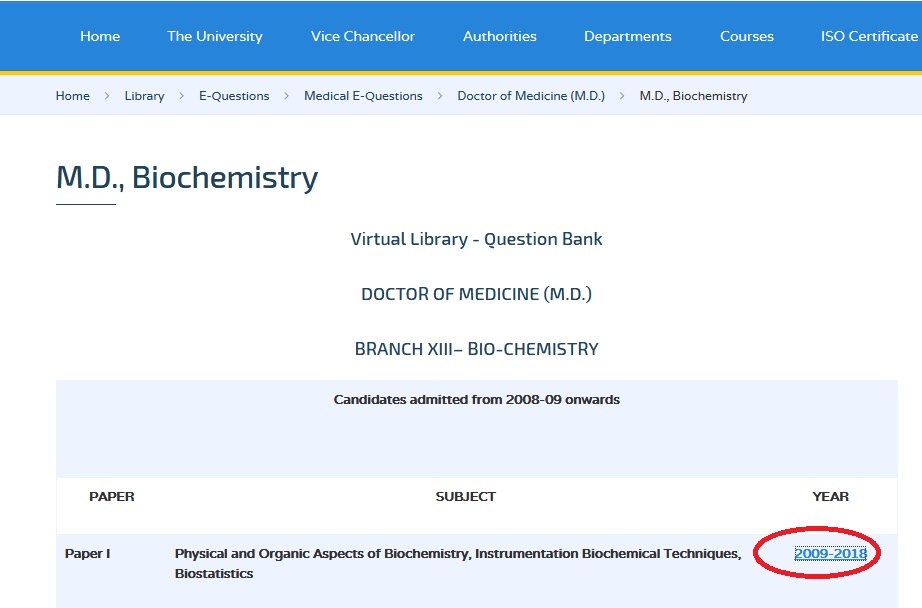Physical & Organic Aspects of Biochemistry, Instrumentation Biochemical Techniques, Biostatistics MD Question Bank : web.tnmgrmu.ac.in
Name of the University : The Tamilnadu Dr. M.G.R. Medical University
Degree : Doctor of Medicine (M.D.)
Branch : Branch XIII – BIOCHEMISTRY
Subject Code/Name : 2043/Physical And Organic Aspects Of Biochemistry, Instrumentation Biochemical Techniques, Biostatistics
Paper : I
Document Type : Question Bank
Website : web.tnmgrmu.ac.in
Download Model/Sample Question Paper :
2009-2014 : https://www.pdfquestion.in/uploads/web.tnmgrmu.ac.in/4298-1-202043KY.pdf
1990-2000 : https://www.pdfquestion.in/uploads/web.tnmgrmu.ac.in/4298-2-202043KC.pdf
2001-2008 : https://www.pdfquestion.in/uploads/web.tnmgrmu.ac.in/4298-3-202043KX.pdf
TNMGRMU Physical & Organic Biochemistry Question Paper
[KU 148] Sub. Code: 2043
M.D. DEGREE EXAMINATION
Branch XIII – BIOCHEMISTRY
(Common to all Candidates)
Paper I – PHYSICAL AND ORGANIC ASPECTS OF BIOCHEMISTRY, INSTRUMENTATION BIOCHEMICAL TECHNIQUES, BIOSTATISTICS
Related : Tamilnadu Dr. M.G.R. Medical University Forensic Medicine in Relation to Medicine & Surgery, Obstetrics MD Question Bank : www.pdfquestion.in/4300.html
March 2009
Q.P. Code : 202043
Time : Three hours
Maximum : 100 marks
Draw suitable diagram wherever necessary :
Answer ALL questions :
I. Essay questions : (2 x 20 = 40)
1. Describe in detail the structure, classification and functions of immunoglobulins.
2. Name the plasma/RBC buffers and urine buffers. Describe the role of respiratory system and the role of kidney in the maintenance of acid base balance.
II. Write short notes on : (10 x 6 = 60)
1. Tonometry.
2. Chemiluminescence.
3. Reference materials.
4. Uronic acids and sugar alcohols.
5. Ion exchange chromatography.
6. Evaluation of diagnostic test.
7. ELISA.
8. Membrane proteins.
9. Sterols.
10. Measurement of radioactivity.

September 2009
I. Essay questions : (2 x 20 = 40)
1. Describe the structure and types of Collagen. Add a note on the relationship of function to the three dimensional structure.
2. Describe the chemical composition, classification of Lipoproteins and their separation techniques.
II. Write short notes on : (10 x 6 = 60)
1. Ion selective electrodes.
2. Blotting techniques.
3. Sphingolipids.
4. Biological role of Dextrin and Cellulose.
5. Gel filtration Chromatography.
6. Computer applications in Clinical chemistry.
7. Correlation coefficient and coefficient of variation.
8. Tandem mass Spectrometer.
9. Synthetic Nucleotides.
10. Flame emission photometry.
March 2010
I. Essay questions : (2 x 20 = 40)
1. Describe the structural organization of adult hemoglobin. Explain the changes occurring at the molecular level during oxygenation.
2. Describe the principles, types and applications of radio immuno assay. How does this technique compare with ELISA techniques?
II. Write short notes on : (10 x 6 = 60)
1. Arachidonic acid derivatives and their functions.
2. Glucose biosensors.
3. Working principle of atomic absorption spectrophotometry.
4. Liposomes.
5. SDS – polyacrylamide gel eletrophoresis.
6. Dietary fibre.
7. Dry chemistry methods.
8. Evaluation of a method of estimation.
9. Scintillation detectors.
10. Determination of primary structure of protein.
April 2011
Sub. Code: 2043
I. Essay questions : (2 X 20 = 40)
1. Explain the principles and steps of Polymerase Chain Reaction (PCR). Indicate the diagnostic applications of PCR.
2. Explain the different structural organization of proteins. Discuss the determination of primary structure of proteins.
II. Write short notes on : (10 X 6 = 60)
1. Haemoglobin electrophoresis.
2. Write briefly on sub cellular fractionation and marker enzymes.
3. Henderson Hasselbalch equation.
4. Osmolarity and Osmolality.
5. Blood gas analysis.
6. Auto radiography.
7. Mucopolysaccharides.
8. Phospholipids and their functions.
9. Flame photometer.
10. Heparin.
May 2011
[KY 148] Sub. Code: 2043
M.D. Degree Examination
Branch Xiii – Biochemistry
Physical And Organic Aspects Of Biochemistry,
Instrumentation Biochemical Techniques, Biostatistics
Q.P. Code : 202043
Time : 3 hours
Maximum : 100 marks (180 Min)
Answer ALL questions in the same order.
I. Essay: (Max.) (Max.) (Max.)
1. Write in detail the various types of labeled immunochemical assays. Add a note on homogenous immunoassays. 6 15 10
2. Define Potentiometry. Explain in detail the principles, applications and advantages of ion selective electrodes. 6 15 10
II. Short Questions :
1. Establishment of reference intervals. 3 8 5
2. Linearity and recovery. 3 8 5
3. Mechanism of antibody diversity. 3 8 5
4. Acute phase reactants. 3 8 5
5. Apolipoproteins and their functions. 3 8 5
6. Gibbs Donnan Equilibrium. 3 8 5
7. Name the glycosaminoglycans. Add a note on their structure and function. 3 8 5
8. Principles of flurimetry. 3 8 5
III. Reasoning Out :
1. Laboratory results for glucose shows a standard deviation of 12, mean of 101 mg/dL, whereas for creatinine the observed standard deviation is 0.5 and mean is 1.2 mg/dL. The quality manager judges analytical performance for glucose to be better than that of creatinine. Justify. 4 10 5
2. PAGE for protein separation requires stacking gel. Explain. 4 10 5
3. 2, 3 DPG decreases the affinity of hemoglobin for oxygen. Explain. 4 10 5
4. Reverse sequencing of proteins need to be supplemented by mass spectrometry. Explain. 4 10 5
IV. Very Short Answers :
1. Significance of Inosine. 1 4 2
2. Receiver Operating Characteristics Curve. 1 4 2
3. Omega 3 fatty acids. 1 4 2
4. How will you check the photometric accuracy of a spectrophotometer? 1 4 2
5. Urine preservatives. 1 4 2
6. Stains used in protein electrophoresis. 1 4 2
7. Coagulation of protein. 1 4 2
8. Limiting aminoacids. 1 4 2
9. Ceramide. 1 4 2
10. Structure of starch. 1 4 2